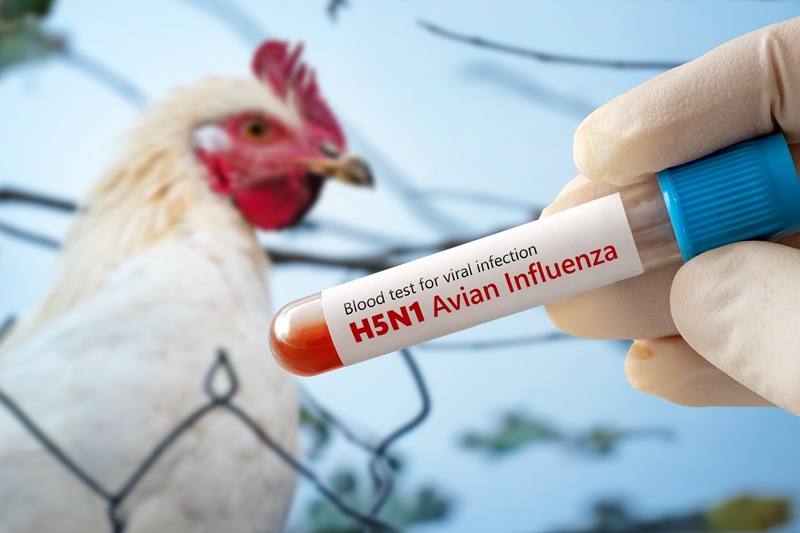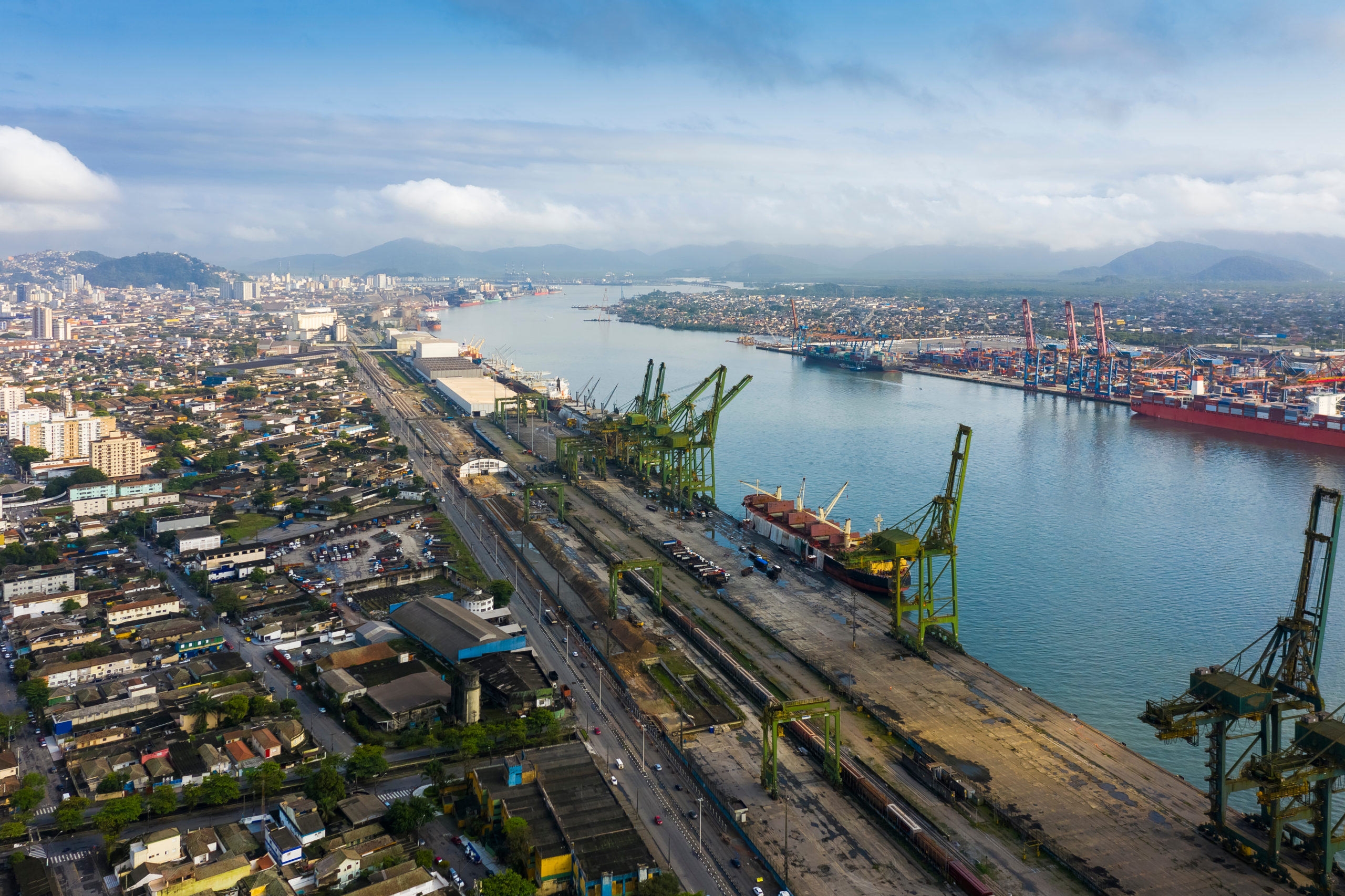
Ministry of Agriculture confirms avian flu ca...
read more

Latin America’s largest and busiest port complex, the Port of Santos, Southeast Brazil, features a narrow, winding and shallow access channel with an average width of about 200 metres. Vessels that navigate the channel generate waves or backwashes due to their displacement and propeller thrust that can cause moored vessels to move along or off the berth.
The so-called “wash damage” typically results in straining or parting of mooring ropes and damage to gangway ladders of vessels berthed along the port channel. If the hydrodynamics forces involved are too strong – or the mooring lines are too slack –, there may be direct contact or a snapback of the bow or stern of the moored vessel against the quay wall or pier, causing damage to the hull, bollards, fenders, quayside structures, and cargo handling equipment.
These incidents are typically caused by the wave effect of large containerships and deep-draft bulk carriers proceeding inbound or outbound the navigation channel, not necessarily exceeding regulatory speed limits or passing too close to the berthed vessel.
The intensity of port traffic grows every year, as does the size of vessels that call at this key Brazilian port. At the same time, port operations are faster than ever, leading to rapid changes in the vessels’ drafts – and constant slackness of their moorings that must therefore be constantly tended to by the crew.
Visiting shipowners and masters should be aware of the potential increase in the number and severity of such incidents and the recommendations provided by the local authorities. To help with this task, we provide below an overview of the relevant regulations and practical advice for preventing wash damage – or handling the resulting claims when this happens.
According to the Rules and Procedures of the Captaincy of São Paulo (NPCP 2016), the maximum speed allowed in the navigation channel of the Port of Santos is 9 (nine) knots. The speed should be slowed down to 5 (five) knots in the vicinity of yacht clubs, marinas, and fishing terminals located on the channel’s banks, also observing the COLREGS 1972 rules.
Based on the latest bathymetric results carried out by the Santos Port Authority (SPA), effective from 31 May 2021, the Maritime Authority approved changes in the draft limits of commercial berths and along the navigation channel under its jurisdiction, as illustrated below.

Figure 1: draft at the navigational channel of the Port of Santos (Rev. 238). Source: SPA
The current draft limitations are subject to change without prior notice.
Given the peculiarities of the port channel, the Port Captaincy’s NPCP 2016 provides recommendations for the mooring of vessels and tending of the lines, as quoted below, in rough translation:
QUOTE
(…)
0404-ANCHORS AND MOORING
SAFE MOORING OF VESSELS TO THE QUAY
The Port of Santos has heavy traffic of vessels, some of which are large (length > 300 m, beam > 43 m and drafts above 13 m). Its access channel is narrow, winding, and shallow. On each of its banks, complex and important port facilities are located very close to the general line of the berth. Due to these characteristics, vessels moving in the channel (mainly large ones), sailing at short or medium distance, transversely, from berthed vessels, at high or low speed, due to hydrodynamic interactions and surge produced, tend to cause undesirable longitudinal movements to the berthed vessels, by bringing their bow or stern closer or farther away from the quay, therefore requiring effort from their mooring lines, which may, if they are not in good condition or have not been adequately fastened to the shore bollards, cause their partial or total rupture and damage to their structures as well as gangway ladders.
In addition, part of the quay at the Port of Santos is old, built with superimposed stone blocks; in general, needing periodic works to maintain the structural resistance compatible with the displacements of vessels that dock there, the Port Authority and Terminal being responsible for ensuring receipt of vessels with displacements compatible with the structural strength of the berthing site, as well as for ensuring that there is sufficient clearance for berthing between vessels of at least 10% of the LOA (as in the case of vessels with LOA ≤ 200 m) and at least 15% of the LOA (for vessels with LOA > 200 m).
Therefore, the shipping agents must alert the masters of vessels under their agency regarding the aspects discussed above and the need to use mooring ropes with compatible resistance/elasticity coefficients, in quantity (bowlines and springs), devices (single or double) and adequate state of conservation, as well as the need for constant vigilance, to prevent them from becoming unduly slack or tighten, taking into account the fluctuations in tide heights and the loading or unloading operation carried out by the vessel.
Likewise, Terminal Administrators must ensure the maintenance of their structural conditions; to ensure that the berth is free from any equipment or its attachments, close (less than two meters), or shot out of its general line, which jeopardises the safe approach of vessels for berthing, giving rise to the possibility the manoeuvre being aborted, for the sake of safety. It is incumbent upon the Terminal Administrators to also ensure that there is an adequate number of fenders, and conveniently distributed between the vessel and the terminal, to fulfill the role of “defending” the berthed vessel, evenly along the quay against possible touches in the Terminal, and without the risk of demanding more effort from the vessel’s mooring lines than is due. Below are illustrations as examples of a possible safe mooring device for a vessel to the pier:
Picture 1
Picture 2
UNQUOTE
The maritime authority may open an inquiry to establish the responsibility for the incident. However, the investigation will not be concerned with the determination of civil liability, which otherwise must be adjusted between the interests of the vessels involved or settled through litigation or arbitration.
The SPA regulates the terms and conditions for commercial port traffic, berthing and operation of vessels within the organised port. The berths outside SPA’s jurisdiction, such as those in upstream Piaçaguera Channel, are directly regulated by the Port Captaincy.
Resolution DIPRE 150/2020 of 26 August 2020 issued by the SPA provides recommendations for mooring arrangements to be adopted for the berths under its management, according to the type and size of the vessel. The port authority regulation also provides a form for reporting the breakage of mooring ropes of berthed vessels. The relevant passage of the port regulation dealing with mooring procedures reads as follows, in free translation:
QUOTE
The Mooring Plan
Art. 39. The mooring plan complies with the criteria expressed in Annex I.
§ 1. The mooring plan is a suggestion from the Port Authority, aiming at the best practices for staying in the port. The responsibility for the ship’s safety lies with the Master, who, in turn, may choose to adopt another mooring arrangement, always in line with the appropriate attributions under Chapter 4 of NORMAM-13/DPC (Norms of the Maritime Authority for Waterway Workers).
§ 2. Shipping Agents and Terminal must encourage the Masters to inspect or have the vessel inspected daily, to make sure of the safety conditions, as well as to reinforce the importance of the role of the Gangway Watchman to inspect, periodically, when the vessel is berthed, the situation of mooring lines, rat guards, ships that may be moored alongside, fenders, regulatory signage and lights.
§ 3. The occurrence of breakage of mooring lines must be reported through the Mooring Rope Breakage Notification Form (NRC), contained in Annex II, and reported to the mailboxes supop@brssz.com and cpsp.secom@marinha.mil.br within 48 (forty-eight hours) after the accident or fact.
UNQUOTE
Regardless of whether there is an official inquiry, the conclusion of which may take a long time to come out, in most cases a joint assessment of the resulting damages is advisable. Ideally, this can be agreed upon between the shipowners involved, with the assistance of their respective P&I insurance providers. The joint survey should be conducted as soon as possible, without prejudice.
The quantification of wash damage losses is essential to determine whether P&I (or Defence) insurers will be financially concerned and assist in seeking security for the losses suffered, whether amicably or judicially.
The local correspondent should be able to assist with the collection of evidence. The investigation must address, inter alia, how the affected vessel was berthed, the speed developed by the passing vessel, whether other vessels passed at or near the time of the event, whether vessels in the vicinities or elsewhere in the port were affected, whether relevant CCTV footage is available and the extent of resulting losses.
The VDR and AIS system must always be switched on, vessel’s speed closely monitored and adjusted to comply with the speed limits imposed by port regulations.
During port entry or departure, the bridge and deck crews must observe whether moored vessels are moving due to the surge or wake created by their vessel underway. They must verify that the lines of the displaced vessels are, as far as they can see, adequately tended or otherwise, record their identity and, if possible, the layout of their mooring arrangement.
In the event of noticeable damage to a berthed vessel or port structure, the Master of the passing vessel must immediately inform the compulsory port pilot, the local authorities, agents, shipowner, and the local correspondent. The latest VDR data should be saved for later retrieval, if necessary.
The VDR and AIS systems must remain switched on during the entire port stay. The vessel must be sufficiently moored according to the vessel’s operational plan and observing the standing mooring recommendations. The duty officer must be familiar with the local tide table and ensure that the crew tends the moorings at a frequency compatible with the vessel type and berth, tidal regime and rates of cargo loading (or unloading) and deballasting (or ballasting).
If a passing vessel generates a surge causing a berthed vessel to move or break off from her moorings, the master or duty officer must take immediate steps to regain control of the vessel and safely fast her alongside, seeking pilot and tug assistance, if necessary. The shipowners, pilot station, local authorities, agents and correspondent must be promptly notified of the incident and any imminent risk to navigation or the environment. The passing vessel must be formally protested at the earliest opportunity and asked to preserve evidence, especially the VDR data.
Please read our disclaimer.
Related topics:
Rua Barão de Cotegipe, 443 - Sala 610 - 96200-290 - Rio Grande/RS - Brazil
Telephone +55 53 3233 1500
proinde.riogrande@proinde.com.br
Rua Itororó, 3 - 3rd floor
11010-071 - Santos, SP - Brazil
Telephone +55 13 4009 9550
proinde@proinde.com.br
Av. Rio Branco, 45 - sala 2402
20090-003 - Rio de Janeiro, RJ - Brazil
Telephone +55 21 2253 6145
proinde.rio@proinde.com.br
Rua Professor Elpidio Pimentel, 320 sala 401 - 29065-060 – Vitoria, ES – Brazil
Telephone: +55 27 3337 1178
proinde.vitoria@proinde.com.br
Rua Miguel Calmon, 19 - sala 702 - 40015-010 – Salvador, BA – Brazil
Telephone: +55 71 3242 3384
proinde.salvador@proinde.com.br
Av. Visconde de Jequitinhonha, 209 - sala 402 - 51021-190 - Recife, PE - Brazil
Telephone +55 81 3328 6414
proinde.recife@proinde.com.br
Rua Osvaldo Cruz, 01, Sala 1408
60125-150 – Fortaleza-CE – Brazil
Telephone +55 85 3099 4068
proinde.fortaleza@proinde.com.br
Tv. Joaquim Furtado, Quadra 314, Lote 01, Sala 206 - 68447-000 – Barcarena, PA – Brazil
Telephone +55 91 99393 4252
proinde.belem@proinde.com.br
Av. Dr. Theomario Pinto da Costa, 811 - sala 204 - 69050-055 - Manaus, AM - Brazil
Telephone +55 92 3307-0653
proinde.manaus@proinde.com.br
Rua dos Azulões, Sala 111 - Edifício Office Tower - 65075-060 - São Luis, MA - Brazil
Telephone +55 98 99101-2939
proinde.belem@proinde.com.br